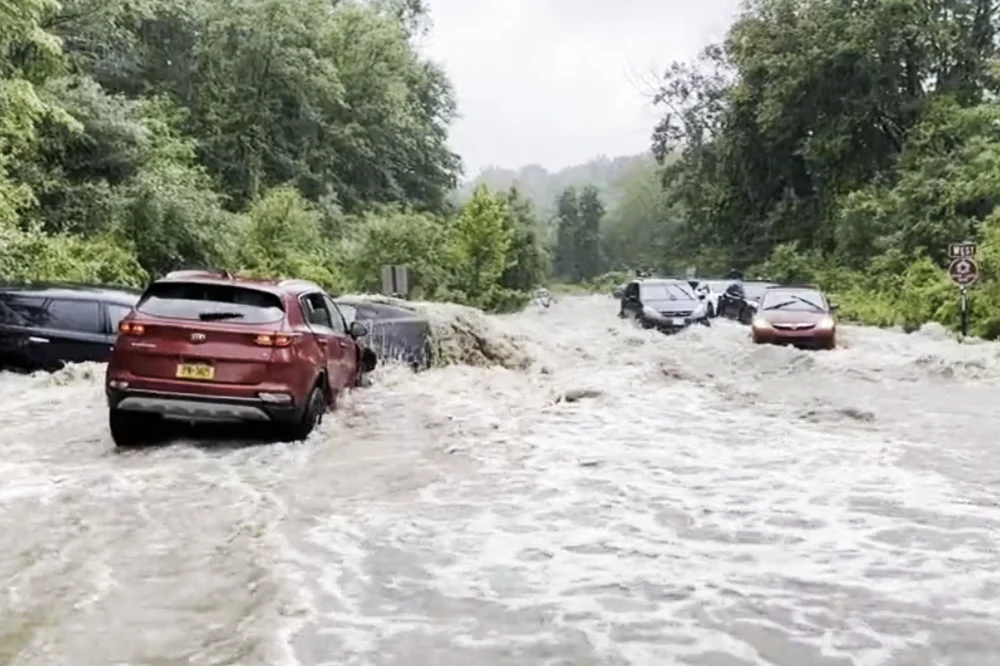- Is there a flash flooding emergency in New York State?
- How many casualties have been reported due to flash flooding in New York State?
- Are the flash floods in New York State a result of climate change?
- How are emergency services coping with the flash flooding in New York State?
- Are other states in the Northeast region affected by flash flooding?
On July 10, 2023, heavy rains caused flash flooding in parts of New York State, leading to at least one death and many rescues. The storm, which also affected neighboring Vermont, dumped more than six inches of rain in some areas in just a few hours, overwhelming drainage systems and leading to dangerous conditions on roads and in low-lying areas.
As extreme weather events become more frequent and severe, many are asking whether climate change is to blame for the recent flooding in New York and other parts of the world. This article will examine the science behind the link between climate change and extreme weather events like flash flooding, and explore what can be done to mitigate the effects of these events in the future.
- Forbes: Heavy rains caused flash flooding in New York State, with at least one reported fatality.
- Washington Post: Northeast storms result in flash floods and heavy rainfall, posing a threat to the region.
- Fox Weather: NY’s West Point faces flooding as rescues are underway due to heavy rains.
- Axios: Northeast storms lead to flash flooding in New York and Vermont, prompting concerns over the region’s infrastructure.
What is Flash Flooding?
Flash flooding is a type of flooding that occurs when heavy rainfall overwhelms the capacity of rivers, streams, and other drainage systems. Unlike regular flooding, which can occur over days or weeks and is often caused by sustained rainfall or snowmelt, flash flooding can happen in a matter of hours or even minutes.
Flash floods are particularly dangerous because they can occur without warning and can be extremely fast-moving and powerful. They can cause damage to homes, businesses, and infrastructure, and can lead to loss of life.
What Causes Flash Flooding?
While flash flooding can occur in any region, certain factors can increase the likelihood and severity of these events. These include:
– Heavy rainfall: The most common cause of flash flooding is heavy rainfall, which can overwhelm drainage systems and cause rivers and streams to overflow their banks. In areas with steep terrain or poor drainage, even a few inches of rain can cause flash flooding.
– Urbanization: As more land is developed for housing, businesses, and infrastructure, the natural landscape is replaced with impervious surfaces like pavement and concrete. This can increase the amount of runoff during rainstorms, leading to flash flooding.
– Deforestation: Trees and other vegetation play an important role in regulating the water cycle, absorbing rainfall and releasing it slowly into the ground. Deforestation can lead to increased runoff and soil erosion, making flash flooding more likely.
– Climate change: As the planet warms, it is expected to lead to more frequent and severe extreme weather events, including heavy rainfall and flash flooding. Warmer air can hold more moisture, leading to more intense rainfall when storms do occur.
Is Climate Change to Blame for the Recent Flooding in New York?
While it is impossible to attribute any single weather event to climate change, scientists have warned that the increasing frequency and severity of extreme weather events like flash flooding are consistent with what is expected in a warming world.
According to the Intergovernmental Panel on Climate Change (IPCC), extreme rainfall events are becoming more frequent and intense in many parts of the world, particularly in North America and Europe. The IPCC also warns that the risk of flash flooding is likely to increase in the future as the planet continues to warm.
A study published in the journal Nature in 2017 found that the likelihood of extreme rainfall events like the one that caused the flooding in New York on July 10 had increased by as much as 60% in some regions of the world due to human-caused climate change.
What Can Be Done to Mitigate the Effects of Flash Flooding?
While it may be impossible to prevent flash flooding entirely, there are steps that can be taken to reduce the risk of damage and loss of life. These include:
– Developing better early warning systems: Improved weather forecasting and early warning systems can help communities prepare for flash flooding and evacuate when necessary.
– Investing in infrastructure: Upgrading drainage systems, building sea walls, and other infrastructure improvements can help mitigate the effects of flash flooding.
– Preserving natural landscapes: Protecting forests, wetlands, and other natural landscapes can help reduce the risk of flash flooding by absorbing rainfall and slowing down runoff.
– Reducing greenhouse gas emissions: The most effective way to reduce the risk of extreme weather events like flash flooding is to reduce greenhouse gas emissions and slow the rate of climate change. This can be done through a combination of policies like carbon pricing, renewable energy mandates, and investment in clean energy technology.
Conclusion
The recent flash flooding in New York is a stark reminder of the devastating effects of extreme weather events and the urgent need to address the underlying causes of these events.
While it may be impossible to prevent flash flooding entirely, there are steps that can be taken to reduce the risk of damage and loss of life, including developing better early warning systems, investing in infrastructure, preserving natural landscapes, and reducing greenhouse gas emissions. As the planet continues to warm, it is imperative that we take action to mitigate the effects of climate change and protect our communities from the increasing risks of extreme weather events like flash flooding.
